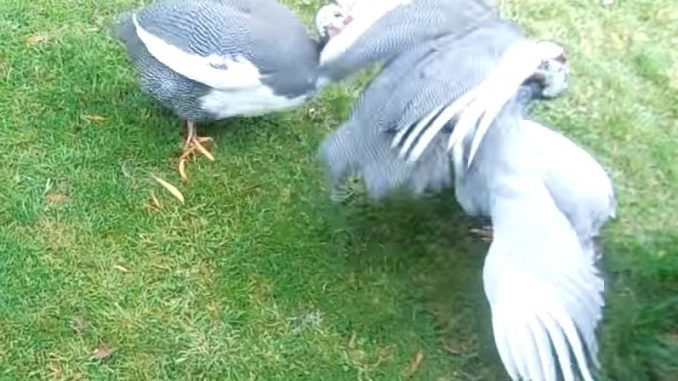
When looking at Guinea Fowl behaviour, it’s good to realise right up front that they are very different to hens and roosters.
These birds are a breed of their own and act accordingly. Whatever you are used to, trust me, it will be quite different with these wonderful, crazy, and thoroughly entertaining birds!
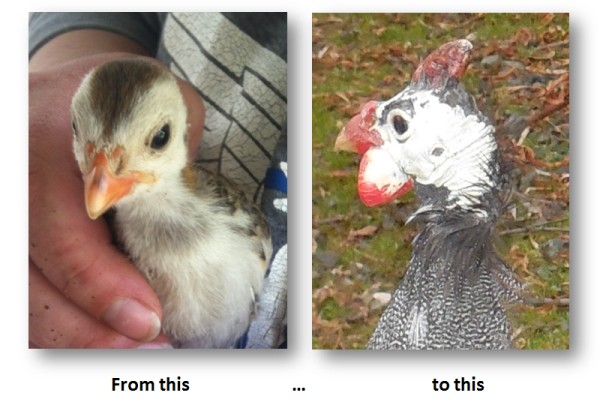
As mentioned in some of my other writings, I started off with just seven of these creatures as little baby keets. How cute they were, but they were hardly a week old when they were flying all around the little coupe I had them in, together with their mother… a hen. I had to get to work and create a much larger pen to house them safely.
Their wings are amazingly strong… in fact, we are told never to pick a guinea up by the legs (or a keet) as they have the potential of breaking them when they swing around. I recently watched a man I bought a silver guinea from, catch the bird by its wing… it definitely worked and didn’t harm the bird.
Guinea Fowl behaviour when finding a girl
The guineas have two seasons. In Australia, from October through to March is when they mate and the females lay their eggs. From April through to September is when they all come together and move around the property in one group. During this period, they lay no eggs at all.
A couple of weeks before mating season is when the serious business of choosing a mate takes place. Now most people online say they mate for life, but my birds can tell you quite different to that! If it was up to the girls, I believe they would stay with their mate forever. If they could choose, they would remain with their mate year round… but you see, it’s the boys who decide. The girls just have to get used to whatever arrangements the boys sort out. I mean it, the boys will fight until it’s sorted.
This is Silver and Streak fighting over a female… not sure whether it’s Penny or Grace. Notice how upset she is over the fighting and the way she runs at them to try and break it up. That kind of behaviour doesn’t always happen, but can on occasions.
Let me give you an example of how they can change mates…
- Silver started off with Sally. The next year he was with Lavender. The following season, he again took Lavender until she died. Then he fought for Grace and changed midstream for Sally.
- Meanwhile, Pied and Penny have always been a couple except for one year when another male claimed her. That year, Pied didn’t take another female but instead formed a threesome with Gray and Grace… two males and one female.
- Streak, on the other hand… one year he had two girls, Lavender and Sally, which created another threesome… one male and two females. Usually he had either Lavender or Sally but this last year Sally was taken from him and he ended up with Grace… who was also pinched off him at the end! He always tended to be happy with whoever was left over. He was a great friend to all.
- Both the threesomes happened two seasons ago.
I do not believe there is any ‘normal’ behaviour when it comes to sorting out who will go with who.

How the females call
During the pre-mating season, the girls will call. My men dislike this time as they say it drives them crazy. The girls continue to call until a male responds to them. They might have it in their minds which boy they’d like to have, but it will be whichever male decides on her.
A female calling for a male.
I’ve had guinea fowl for approximately four and a half years at this point in time, which means we have been through four pre-mating seasons. The first three times we had to put up with a lot of calling from the girls, but this last time it was quite different as they all just fell into having the same mate as the year before. We couldn’t believe it was all accomplished so easily. No problems. My menfolk were very happy!
But… catastrophe struck!
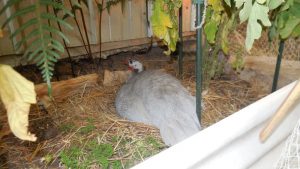
I had four pairs, but Lavender, my silver female, died. (Lavender is the name of the colour of the silver looking birds. Some call them ‘silvers’ and others call them ‘lavenders’. They are definitely silver in colour but with a nice lavender hue, especially around the neck area. They are very pretty.
Anyway, back to my story… Lavender died, which left both me, and Silver (her partner), very sad. He cried out for her for days. I made sure that he got to see her so that maybe he could understand that she was gone… whether it helped or not I have no idea. But he truly missed her.
After his mourning period was over he set his eyes on one of the other girls called Grace. The problem was, Grace was with Streak at the time. (She originally was Gray’s girl… Gray & Grace I called them back then).
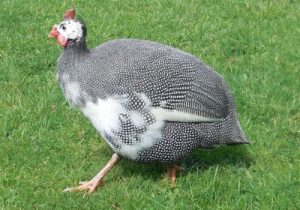
Streak was my overall favourite bird as he had such a wonderful, friendly nature. I called him Streak because of the white wing feather that showed only on one side. On the other side you could only see grey feathers.
He wasn’t a bully as male guinea’s can be, especially towards the hens who they love to terrorise! I didn’t have to teach him to eat out of my hand, he just did. One day he simply jumped up on my knee and ate seed out of my hand… as if he’d been doing it all his life!
Oh no! I lost my Streak!
About three weeks after Lavender died, I lost my little Streak. I was so cut up and I couldn’t understand what happened to him, but I do know he was very sick. A couple of days before he died, Silver decided to challenge Streak for his Gracey, and he quite easily won the battle. At that time I didn’t even realise that Streak was sick, but the challenge really took it out of him. He didn’t recover, although I’m certain it wasn’t the fight that killed him, but rather that he was already dreadfully sick. They have the ability to hide their sickness very well so they don’t become easy prey for the birds of prey. Makes sense, doesn’t it.
Will they bond or not?
After the loss of Lavender, it meant I had only three girls for four boys. So I decided to buy another female quickly as I knew it would create trouble if I didn’t have them equal, so I bought another silver female to give to my boy, Silver. This would allow Streak to go back to Grace. So I bought the new bird and locked her up with Silver for two weeks to allow them to bond… that was my hope.
Well, all my aspirations went belly-up didn’t it! There wasn’t any hope of getting these two silver birds to bond and become mates because… it turned out that the new bird was a male. Oh no!
He had the wattles of a female (flat against the side of the head), but in every other way he was male… very male! It’s funny how I got caught out because I knew his helmet (on top of his head) looked male but it wasn’t as big as my other boys. Although this photo doesn’t show it clearly, the wattles are very flat exactly the same as a female. The boys’ wattles are big and puffy.
Then with Streak dying on me, I was back to having seven birds again… three females and four males. 🙁 Now I thought… if only I hadn’t bought the new bird!
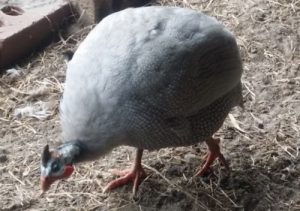
Once I realised the new bird was a male, I called him ‘Stirling’. He has a lovely nature and at least at this time he doesn’t terrorise the hens. He sleeps and eats with them no problems at all. It will be interesting to see as he becomes more and more used to them, as to whether he will start this annoying habit.
Now the serious fighting begins!
Well, Silver and Stirling, once they were released, began some serious fighting over Grace. Silver seemed to come out of it alright, but Stirling’s feathers were a ruffled mess. But he is a very determined bird, and kept on.

I want Grace… er no… Sally!
Somewhere in all this, I don’t know why it happened, or how, there was a change in the girl they were fighting over. Suddenly, for some unknown reason, they were fighting over Sally! To add to this, Gray was caught up in it all as well, as Sally was his girl!
Now I had three males fighting over Sally, who didn’t know if she was Arthur or Martha, while poor Grace was left by the wayside.
Now Grace, being left without a mate, began her incessant calling… but no-one came… no, they had their eyes set on Sally.
Gray in hiding!
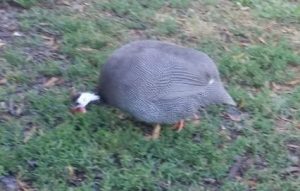
Now Gray had always been the dominant bird, but how this happened I cannot tell, suddenly he was on the run. Both Silver and Stirling chased him off so much that he went into hiding. I couldn’t find him no matter how much I looked, or called. He appeared at night for his feed and to be locked up, but was gone again first thing in the morning. What a change… I had never seen him this way before.
After about four days of serious fighting and chasing each other around and around and around… suddenly it all quietened down. Silver was now with Sally, and Stirling was with Grace. Gray was back again, but was tending to keep to himself, or sometimes, I noticed him walking around with Pied and Penny.
I have tried to buy another female but have not been able to find any available. So at this point in time, my hope is that Pied and Penny will welcome Gray to form a threesome with them. I’ve seen this before when Gray & Grace welcomed Pied into a threesome.
Tell me, is your head in a spin?
I guess your head may be spinning with all these names, and the changes. As I say, mating for life is not always an option. Some guineas definitely may do it, but not my guys!
This video is when Stirling was after Sally. You can tell by her calling that she’s not completely happy with the idea. He is also quite agitated, and it’s easy for me to know that it’s not yet settled. Look at his ruffled feathers! Of-course, the outcome was that Silver came back and fought it out for Sally.
Then suddenly Stirling must have realised that Grace was available… and that’s when everything finally settled down… I thought!
Yes, I thought it was all over, but my males have continued to spat over the last number of days and I’m not quite sure who they are fighting over. It seems to be Sally one moment and Grace the next. I’ve not seen them quite like this before. I can’t wait to find another female to calm the situation down.
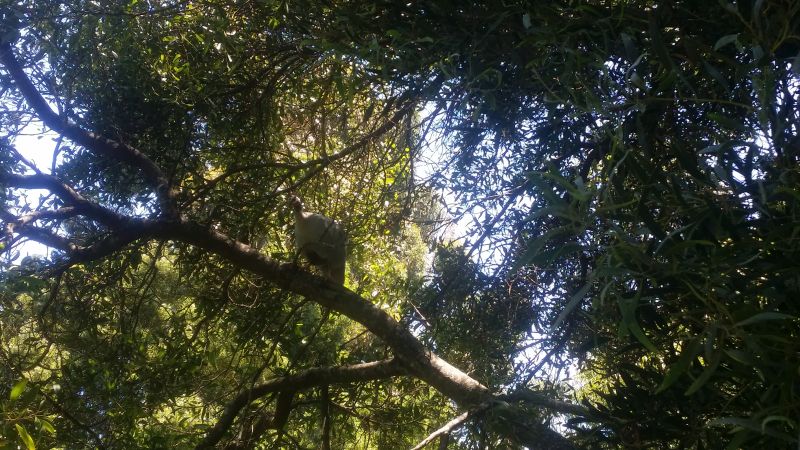
This is Stirling taking refuge high up in a tree. He’s not in hiding, but certainly taking a break from all the fighting.
So, is there a moral to this story?
What have I learned from my experiences?
If you owned a whole group of guineas you wouldn’t really know what was going on, but because I have only 4 pairs, or thereabouts, I know each of them intimately. I wouldn’t really want to change this as it’s been a wonderful experience learning about their individual habits and customs.
But I would consider having fewer males and more females. I think if I had two males and four to six females it would have worked better. The trouble was I loved all my little keets and wanted to keep them all and simply equal it out.
Basically, I have found the males are the more interesting as they have lots of little quirky ways that the females don’t have.
What my Guinea Fowl are currently doing…
I have to confess that I had to get up off my chair and go for a wander around the property to check out which birds was with whom! I can tell you for sure that the current situation is:
- Pied, Penny & Gray are wandering around together as a threesome. I just saw Gray and Penny eating closely together while Pied was about 3 metres away from them contentedly eating grass. Normally this would never happen as Pied would drive Gray away. Pied and Gray have always been great mates so I’m happy to see this happening.
- Stirling is currently standing guard as Sally is laying an egg in a nest.
- Silver and Grace are wandering the property as a couple.
Two weeks later…
It didn’t take long before I found they had rearranged themselves again:
- Gray has reclaimed Grace
- Pied & Penny are happy to continue to be a pair
- Silver, Stirling and Sally have created a threesome although Silver is not 100% happy about it, but many times I see the three of them sitting closely together without problems.
A day or two later…
Today Stirling and Silver have decided the fight is on. Take a look at the video… a lot of running around to start with as it erupts into fighting as the video continues.
So you can see that guinea fowl behaviour when it comes to mating is very different from other domestic birds and overall are a lot of fun to own.
Do you own guinea fowl? If so, what have you experienced with their antics?
![]()







Hey there, I wanted some insight and opinion from all your experience with guineas. We had a broody hen hatch out 9 keets, we lost 2, so we currently have 7. I do believe there is only 1 female. They hatched in the spring. We tried training them to their own coop, but that’s how we ended up losing 2, so now they’re in the chicken coop where they like going to roost (because they had a chicken mom lol). So my question is, we had a neighbor a few miles away ask is he could buy a few. I’m concerned if they’re bonded to each other about selling, but now I’m wondering if it could be a good thing because I have so many males. Let me know what you think. The neighbor has hens, and is able to take care of them and keep them safe.
Hmmm Anne, it’s a good question. Let’s think it through. You believe you have 6 males and one female. That could be very interesting once breeding times arrives.
If just one set bond as a pair, the other 5 males will be without a mate.
I have seen them share a female though, at least 2 males with one female. Very happy they were with no problems.
Problem is, there could be an awful lot of fighting before they settle down and accept whatever the result is.
As the bachelor males will be looking for a female, they would be more than happy to go wherever that female is. Your neighbour may need to go find a female or two and bond them. Not much use giving him a few males unless he decides to buy females in. In fact, yes… the guineas could return to you.
Once breeding season comes, I believe the bond between male and female will be stronger than sibling relationships… although they will still be a group.
I hope that helps you a little.
I’d love to hear of the outcome!
I have 6 guinea fowl. Unfortunately, it appears that I have 4 males and only 2 females. Not sure as they are still young and I’ve only had them for a few months. I have a question. One of the birds is excluded from the flock. The dominate male guinea will not let it eat or even travel with the rest. He keeps running the smaller bird off. The other five all huddle together, move together, eat together . . . The smaller bird has actually learned to eat when everyone else is done. It seems to avoid the flock. Anything I can do?? The only positive thing that I’ve noticed is that if the “excluded” bird gets TOO far away, everyone squawks an alarm until it moves and can be seen by the other five.
Hi Elizabeth,
Thank you for contacting me regarding your guinea fowls.
As you would have read on my website, I started out with 7… 5 males and 2 females. It was not a mix I would recommend! We took care of it by buying in other adult females… and you can read all about my adventures with that.
We too had a situation where ‘Grey’ would not allow ‘Silver’ to be part of the group. I loved Silver all the more because of this. But anyway, he became very close buddys with one of my chickens so it helped him immensely.
When mating time arrived… I think the second season, Silver took matters into his own hands. He fought so hard for his rights that he became the force to be reckoned with. From that point on, he could have whichever female he so desired each season… and it did change from one to the other.
One season Silver pinched Lavender who belonged to Streak! Streak and Lavender had already paired up but Silver had other ideas.
In our case, we thought the problem was more that Silver was silver in colour, (sometimes known as Lavender) and therefore different that Grey took such a disliking to him. It may have been, or not… I don’t really know.
I got to know my birds so well could generally always work out what the problem was they were experiencing, but at the end of the day, they will basically have to sought things out for themselves.
Sometimes they will form threesomes… either 2 boys to 1 girl, or 2 girls to 1 boy. This worked very well also.
So we sold 1 male which left us with 4. We bought 2 other girls. You have to keep them locked up in a separate area so they can bond for about 2 weeks. The only time this didn’t work for me was when I bought a male, being told it was a female. I tried to bond 2 males together… guess what? It doesn’t work!
I love the fact that you said the other birds are still on the lookout for the excluded bird. They are an incredible species of birds which provide you with never-ending entertainment… if not a few headaches!
Please read through all my guinea fowl/keet posts. You will find much there which should help you… right down to the colour of your clothing.
Feel free to contact me at any time and I’ll help wherever I can.
We currently have 14 guinea, and 12 chickens. We (husband) and I are “city dwellers” who moved to another state and live in the country. We thought it would be “fun” to start a bird family. Four hens were already producing eggs. We call them the “ Reds “ as they are all red. Got eight little chicks and within a week received 16 baby keets. I don’t know what I was thinking. I read that guinea fowl were great for bug and tick control. We have lots of acreage and a fresh spring. We raised guinea and chicks, now known as “greys” next to each other in our shop. They all thrived and grew. The greys were very friendly and still crave attention. The guineas always huddled together and ran to other side of enclosure when we fed or came near them. Once the guinea started flying we (husband) built a little compound consisting of two coops and a nice middle enclosure with roof and perches for the guinea. The reds have a coop, the greys have a coop and the guinea have their own enclosure. We have about 1/4 acre fenced with chain link. 3/4 of it has tall trees all around. It has been six months and we have all the birds trained to go into their respective coops (with a little guidance) before sunset. They all get food and have fresh water. We let them all out in the morning. The group gets along, stays together and goes into each other’s coops throughout the day or look for food out back. The guineas are very big! The grey’s are now laying and for a few months we were finding guinea eggs in the chicken’s nesting area in both coops. We give meal worm treats and they all come running! Lately we have a problem with the male guineas not letting all the females into the coop and have to coax them in. We have read that guineas are good flyers. Ours won’t fly. Occasionally they fly a few feet, but that is all We have a lot of open grass areas and hoped they would fly over the fence and start roaming in other areas on the property. We even walked them all out for a little outing to show them. They seemed to enjoy snacking and eating, but went back into gated area and never flew back outside the chain link fence. We coop them at night to keep them safe from predators. Does anyone else have a flock of guineas that seem content to just hang around with the chickens? Another concern is our daughter’s dog occasionally runs loose on the property so we worry that it might attack a guinea if they decide to venture out.
Thank you Jann for relating your wonderful story! I loved reading about your experiences… some of which were so unlike mine. My guineas could certainly fly… all over the top of the house, over our huge shed… really, they can go wherever they want. At mating time we got a lot of flying and sometimes they landed over the farm fence, but found it really hard to come back again as they would only run up and down on the other side of the fence. I ended up cutting little ‘gates’ into the wire netting so I could open it when necessary.
We had a paddock which they would fly over into when the grasshoppers were about. The grasshoppers never bothered with our property as the grass was always kept short, but next door had long grass waiting to be made into hay. They used to find their way over to it, and back again without any problems.
My birds were all trained to go where we wanted them too, but we would run into problems at mating time. There was no way they would all share the same enclosure if they were scabbling during the day. Over the years I’ve learnt to read them so well that I can work out what the problem is, so that instead of fighting them, I was able to find an alternative arrangement. It always settles down in the end.
Hanging around with the chickens is part of what they do… but as they grow older they can begin to learn that they can bully the chickens. I found that the chickens began running away from them… except for those chickens who stood up against them. If the chicken made up its mind that there was no way a guinea was going to bully her and she chased it back, the guinea would never worry her again. They are great bluff artists! Remember that when or if your time comes.
We have a border collie dog, but fortunately we had him from a little pup and he grew up with the birds. The only time he ran ‘at’ them was if a fight broke out amongst them… he would simply run straight for them and birds went in every direction. We have never at any time been worried about him and the birds… they totally co-existed together as they all had free use of the entire property.
If you have anymore questions I’d love to hear them… anytime…
Thanks again… Marilyn
Thank you for your quick response! I will keep you updated with hopefully positive news.
Cool, would love that… I wish you well. I always love to hear how it’s all going….
Thankyou, that explains a lot , I also kept all 7 from my very first guinea hatch last year. happily 4 were female 3 male. Like you I purchased what I was told was a female at a local poultry sale. This bird was a week younger than mine so about 5 months. No bother..straight in with others. Till this year when one of my males decided to attack the new bird. Turns out it was male ! Well all 7 started chasing the poor thing & actuall y drew blood when they caught up with it. so I put him & the spare female together for a couple of weeks & sold them to a neighbour. All I need now is a decent colour chart so I can sort out what colour this years chicks are because none of them are the same as the parent birds!!
Lesley, I would be so interested in how it all works out for you? Such interesting little creatures! It takes a bit to really understand what is going on, but it’s so much better once you work it out. You know that each phase will pass.
Thank you so much. This explains Mad Max (head Guinea) and young Don’s behavior. Don actually drew blood from Mad Max. Took a day for Max to recover. I have only had Guineas and Chickens for 18 months. My Austrolupe hen hatched 6 Guinea’s last year.
Oh that’s great you’re having experience with these incredibly interesting little creatures! Poor Mad Max would not have liked Don treating him in such a manner! Not a lot you can do unfortunately but let them play out what they need to do. I hope they have settled down for you by now.